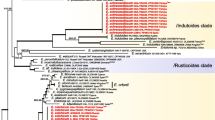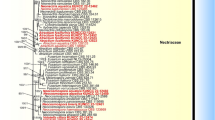Abstract
Based on morphological characteristics and molecular phylogeny, we reclassified Cordyceps cuboidea and allied species C. alboperitheciata, C. prolifica, and Ophiocordyceps ryogamiensis. We investigated their teleomorph-anamorph relationships and revealed that these four species have Hirsutella-like anamorphs with morphological differences between them. By analyzing their molecular phylogeny, inferred from DNA sequences of internal transcribed spacer (ITS) and large subunit (LSU) D1/D2 region of rDNA, they were separated into four close-knit clades. Although C. prolifica and O. ryogamiensis formed their own clades, isolates of C. cuboidea separated into two clades, i.e., a true C. cuboidea clade and one resembling a new species, the O. paracuboidea clade. The latter two species are distinguished by the fruiting region of the stroma. In addition, C. alboperitheciata is regarded as a synonym of C. cuboidea. From the morphology, teleomorph-anamorph relationships, and molecular phylogeny, we concluded these species should be assigned to the genus Ophiocordyceps.
Similar content being viewed by others
References
Artjariyasripong S, Mitchell JI, Hywel-Jones NL, Gareth Jones EB (2001) Relationship of the genus Cordyceps and related genera, based on parsimony and spectral analysis of partial 18S and 28S ribosomal gene sequences. Mycoscience 42:503–517
Felsenstein J (1985) Confidence limits on phylogenies: an approach using the bootstrap. Evolution 39:783–791
Hall TA (1999) BioEdit: a user-friendly biological sequence alignment editor and analysis program for Windows 95/98/NT. Nucleic Acids Symp Ser 41:95–98
Kimura M (1980) A simple method for estimating evolutionary rates of base substitutions through comparative studies of nucleotide sequences. J Mol Evol 16:111–120
Kobayasi Y (1941) The genus Cordyceps and its allies. Sci Rep Tokyo Bunrika Daigaku Sect B 5(84):53–260
Kobayasi Y (1982) Keys to the taxa of the genera Cordyceps and Torrubiella. Trans Mycol Soc Jpn 23:329–364
Kobayasi Y, Shimizu D (1963) Monographic studies of Cordyceps 2. Group parasitic on Cicadidae. Bull Natl Sci Mus 6:286–314
Kobayasi Y, Shimizu D (1976) The genus Cordyceps and its allies from New Guinea. Bull Natl Sci Mus Ser B 2:133–151
Kobayasi Y, Shimizu D (1980) Cordyceps species from Japan 3. Bull Natl Sci Mus Ser B 6:125–145
Kobayasi Y, Shimizu D (1982) Cordyceps species from Japan 4. Bull Natl Sci Mus Ser B 8:79–91
Kobayasi Y, Shimizu D (1983) Cordyceps species from Japan 6. Bull Natl Sci Mus Ser B 9:1–21
O’Donnell K (1993) Fusarium and its near relatives. In: Reynolds DR, Taylor JW (eds) The fungal holomorph: mitotic, meiotic and pleomorphic speciation in fungal systematics. CAB International, Wallingford, pp 225–233
Perrière G, Gouy M (1996) WWW-Query: an on-line retrieval system for biological sequence banks. Biochimie (Paris) 78: 364–234
Saitou N, Nei M (1987) The neighbor-joining method: a new method for reconstructing phylogenetic tree. Mol Biol Evol 4:406–425
Stensrud O, Hywel-Jones NL, Schumacher T (2005) Towards a phylogenetic classification of Cordyceps: ITS nrDNA sequence data confirm divergent lineages and paraphyly. Mycol Res 109:41–56
Sung GH, Spatafora JW, Zare R, Hodge KT, Gams W (2001) A revision of Verticillium sect. Prostrata II. Phylogenetic analysis of SSU and LSU nuclear rDNA sequences from anamorphs and teleomorphs of the Clavicipitaceae. Nova Hedwigia 72: 311–328
Sung GH, Hywel-Jones NL, Sung JM, Luangsa-ard JJ, Shrestha B, Spatafora JW (2007) Phylogenetic classification of Cordyceps and the clavicipitaceous fungi. Stud Mycol 57:5–59
Thompson JD, Gibson TJ, Plewniak F, Jeanmougin F, Higgins DG (1997) The CLUSTAL_X windows interface: flexible strategies for multiple sequence alignment aided by quality analysis tools. Nucleic Acids Res 25:4876–4882
White TJ, Bruns T, Lee S, Taylor J (1990) Amplification and direct sequencing of fungal ribosomal DNA for phylogenetics. In: Innis MA, Gelfand DH, Sninsky JJ, White TJ (eds) PCR protocols: a guide to the methods and applications. Academic Press, San Diego, pp 315–322
Author information
Authors and Affiliations
Corresponding author
About this article
Cite this article
Ban, S., Sakane, T., Toyama, K. et al. Teleomorph-anamorph relationships and reclassification of Cordyceps cuboidea and its allied species. Mycoscience 50, 261–272 (2009). https://doi.org/10.1007/s10267-008-0480-y
Received:
Accepted:
Published:
Issue Date:
DOI: https://doi.org/10.1007/s10267-008-0480-y




